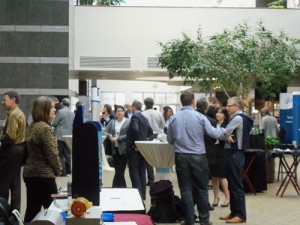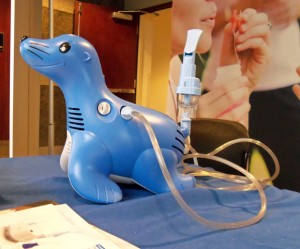
ISAM attendees socialize during a coffee break
The first session of Day 2 of the 2013 ISAM Congress concerned “Aerosol Deposition at the Extremes: Exploring the Limits with Novel Methodologies,” and the most extreme study presented looked at “Aerosol Deposition in Reduced Gravity.” Chantal Darquenne of UCSD described experiments conducted in large part aboard NASA’s parabolic aircraft to study questions related to the possible effects of inhalation of lunar dust by astronauts.
Following that session, the Congress’s second plenary talk addressed pressing concerns here on Earth. The talk, titled “PM Health Update: Where We Are and Where We Go from Here,” was presented by Dan Costa, National Program Director for Air, Climate, and Energy at the US Environmental Protection Agency’s Office of Research & Development.
Costa’s survey of air pollution hazards ranged beyond the particulate matter (PM) of the title. Looking back to the belching smokestacks of the post-war industrial boom, he cited gains made in the US since passage of the Clean Air Act of 1970 as well as continuing challenges into the future.
“The CAA has been very effective but its implementation has largely ignored the realities of air pollution,” Costa cautioned, explaining that the reality involves multiple pollutants that can interact with each other in very complicated ways. The relatively recent recognition that air pollution affects organs beyond the lungs, particularly the cardiovascular system, is one issue, he noted, along with the impacts of explosive population growth and climate change.

Philips Respironics displayed its Sami the Seal compressor nebulizer system
Costa’s talk was followed by an entire session devoted to “The Health Effects of Diesel Exhaust,” with presentations covering topics ranging from the “Epidemiology of Cancer and Diesel Exhaust” to exposure of human volunteers to diesel exhaust.
An afternoon session advertised the congress’s “Best Oral Presentations,” with five talks on subjects ranging from inhaled nanoparticle toxicology to the pharmacokinetics of a novel anti-tuberculosis drug in guinea pigs to designs for efficient aerosol drug delivery to patients on ventilators. Titles and authors of the five presentations are available on this page.
The second “hot topics” session finished off the day with a number of papers on various imaging techniques, continuing a trend started by Phil Kuehl of Lovelace Respiratory Research Institute earlier in the day with a presentation on “Regional Deposition of Inhaled Aerosols in Small Animals by SPECT/CT.” Imaging topics in the afternoon session included “Three-Dimensional Deposition Imaging using Dual Energy Computed Tomography” and “Aerosol Imaging with PET-CT: From Deposition to Tissue Dosing.”
As on Day 1, networking groups gathered after the final paper session for poster discussion over wine and cheese. The Day 2 networking group meetings involved the New Devices and Emerging Therapies group and the Environmental/Occupational Health/Toxicology group.


